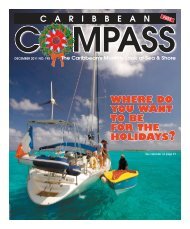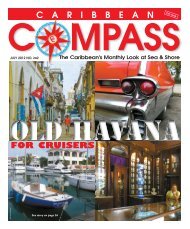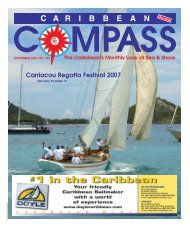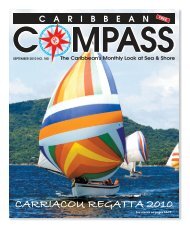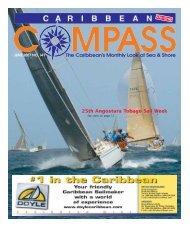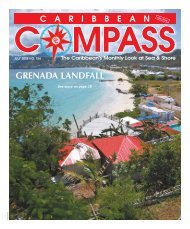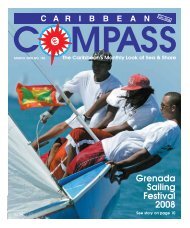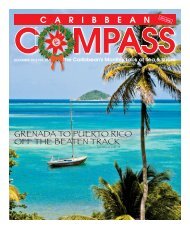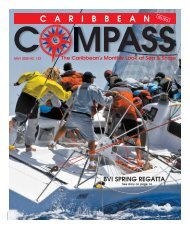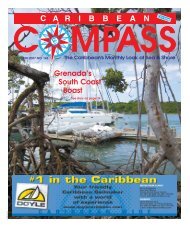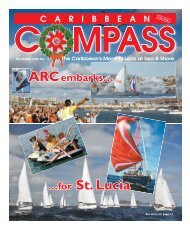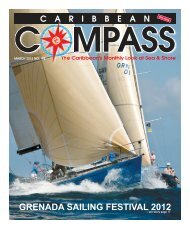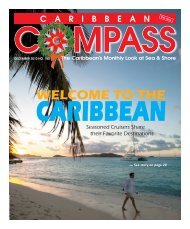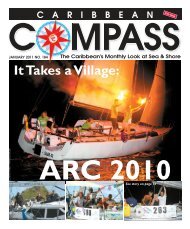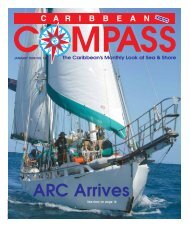Create successful ePaper yourself
Turn your PDF publications into a flip-book with our unique Google optimized e-Paper software.
Letter of<br />
the Month<br />
Dear <strong>Compass</strong> Readers,<br />
I have been reflecting on the subject of reflecting because recent experiences have reminded<br />
me of the importance of good reflection. I will explain, but first some background.<br />
Long ago and far away I spent the best part of six years working as a watchkeeper<br />
on oil tankers. My sea-going travels covered roughly half a million miles, and much<br />
more of this was spent as a junior watchkeeping officer on large vessels. When I say<br />
large I mean nearly 900 feet long and about 110 feet in the beam — not very much<br />
different, in terms of overall dimensions, from many of the cruise ships that we see<br />
around the islands of the Eastern <strong>Caribbean</strong>.<br />
However, there were one or two significant differences, apart from the fact that we<br />
didn’t carry 2,000 or more passengers. The wheelhouse occupied the center portion of<br />
the bridge deck and might have been as much as 50 feet wide. Sliding doors gave access<br />
to the open bridge wings, which extended 30 feet or more to the side of the vessel. In<br />
suitable weather both doors would be open. This meant that in almost all weather conditions<br />
there was easy open access outside. Although the ship’s accommodation would<br />
be either heated or air-conditioned as appropriate, the wheelhouse was not.<br />
The duties of a watchkeeping officer at sea were not arduous. Log entries, position<br />
fixes, weather records — these were but diversions from the officer’s main role which,<br />
above all else, was to maintain a good lookout.<br />
Of course we had radar, which usually had a true motion capability and it was<br />
always used in poor visibility, when approaching port and in heavy traffic.<br />
Nevertheless it is worth repeating that the primary method of detecting other vessels<br />
was by the human eye.<br />
It was recognized that the officers’ night vision might be impaired both by dim<br />
chartroom lighting and instrument lights in the wheelhouse. Therefore it was<br />
required that a lookout be positioned on the fo’csle and his sole job was to report<br />
immediately any lights seen. In bad weather the lookout was posted on a wing of the<br />
bridge.<br />
Compare this simple, effective system with current practice. Think of these vast<br />
floating hotels, resorts and shopping malls which amble at nights between the major<br />
ports of the islands, often converging on their programmed destination as dawn<br />
approaches. Their navigating officers work in a vast air-conditioned control room<br />
with angled glass walls from which they may look down, from time to time, from a<br />
height of well over 100 feet, well above the mast of a cruising yacht.<br />
With at least two “all singing and dancing” radars running constantly their night<br />
vision is, of course, severely impaired and reflected instrument and chartroom lights<br />
must make matters worse.<br />
“What has this got to do with me?” I hear you say. Well, picture this little episode.<br />
A few weeks ago we were on passage from the BVI towards St. Barths. Amazingly,<br />
instead of bashing or beating into 20 knots of wind, we were motoring in a gentle<br />
swell into a breeze of three to six knots. At about 4:30AM we were well off St.<br />
Maarten, which was a large loom on our port bow. A number of other unidentifiable<br />
looms were also visible around us.<br />
Channel 16: “Cruise ship on my starboard bow (repeated), this is sailing vessel Tiny<br />
Tot (repeated). You are on a collision course with me. Have you seen me? Over.”<br />
The call was repeated, then: “Sailing vessel Tiny Tot, this is Monster of the Seas.<br />
There are a number of cruise ships approaching St. Maarten. What is your position?<br />
“Monster of the Seas, this is sailing vessel Tiny Tot, My position is blah, blah, blah.”<br />
“Tiny Tot, this is Monster of the Seas. The cruise ship you are trying to contact is<br />
Costa Carnival Princess. I will contact her for you and give her your position.” (Ah!<br />
The wonders of GMDSS/DSC.)<br />
PAUSE<br />
“Sailing vessel Tiny Tot this is Costa Carnival Princess. I have you in sight and am<br />
altering course.”<br />
Two hours later, shortly before sunrise, we came upon Tiny Tot gently ambling<br />
along at about three knots, tacking her way toward St. Maarten. She was a very tidy<br />
looking double-ended wooden catamaran, properly lit with a very clearly visible trilight.<br />
Clearly visible, that was, to anyone who was outside and keeping a proper<br />
lookout. Unfortunately, to an officer within a huge, dimly lit, enclosed control room<br />
she had been invisible and there could have been a disaster if another vessel had not<br />
relayed the initial call.<br />
As I see it, on a lot of these monsters, radar is everything. (The same applies to<br />
modern container ships and I also worry about a lot of gin palaces motoring around<br />
with both radars spinning in conditions of perfect visibility.) This means that if your<br />
sailing boat doesn’t have a good radar echo, you could be in trouble. Wooden boats<br />
with wooden masts are of course, invisible and if you think that you’re okay in your<br />
plastic boat with an aluminum mast, think again.<br />
The answer must be to have a good radar reflector — obviously Tiny Tot didn’t. By<br />
“good” I don’t mean one of those spheroid or cylindrical jobs that hang from a flag<br />
halyard. Recent scientific tests have found these things to be virtually useless and<br />
they may even be dangerous if they give the owner unjustified confidence.<br />
Good radar reflectors cost at least US$250, but if you want to be seen by a large<br />
modern vessel you’ve got to have one, otherwise you might be in very serious trouble,<br />
even in conditions of perfect visibility.<br />
A couple of days after the Tiny Tot incident we were moored off St. Barths, very<br />
close to a well-set-up cruising yacht which did have a serious radar reflector. Three<br />
days later in perfect visibility, we were two miles off the west coast of Antigua,<br />
approaching Jolly Harbour shortly after sunset. A mile or so astern was our careful<br />
cruiser from St. Barths, and to the north of us was a large cruise ship heading south<br />
from Antigua’s capital, St. John’s. From our position the monster was going to pass<br />
astern. From the other yacht’s viewpoint, things were rather different:<br />
“Cruise ship X-St. John’s (repeated), this is sailing vessel Careful Cruiser on your<br />
starboard bow.”<br />
“Careful Cruiser this is X-St. John’s, how can I help?”<br />
“X-St. John’s this is Careful Cruiser. I am under sail approximately one mile off your<br />
starboard bow. Do you have visual contact with me, and what are your intentions?<br />
“Careful Cruiser, this is X-St. John’s. No — but I have you on my radar and I am<br />
altering course.”<br />
I rest my case.<br />
Christopher Price<br />
Yacht Hummingbird<br />
Wanted<br />
Maintenance Technician<br />
The Yacht Club Bequia, is looking for an experienced Maintenance Technician<br />
to look after all aspects of boat repair and maintenance.<br />
The applicant must be a CARICOM National<br />
and have experience in the following fields:<br />
Marine Diesel Engines, Outboard Engines,<br />
Boat Electrical and Electronics, Refrigeration.<br />
Fiber Glass Repair work beneficial.<br />
Applicants must be prepared to work flexible hours<br />
including Saturdays and holidays.<br />
Salary commensurate with experience.<br />
Applications to :<br />
e-mail: ian@tradewindscruiseclub.com Fax: 784-458-3981<br />
Mail: Manager, Yacht Club Bequia<br />
PO Box 194BQ<br />
Port Elizabeth, Bequia<br />
Bequia Marina<br />
Open Monday to Saturday 8:00 a.m. to 4:00 p.m.<br />
Look for the Big Blue Building.<br />
Water, Diesel, Ice, Bottled Water and Dockage available.<br />
The Yacht Club, Bequia Marina, Port Elizabeth, Bequia,<br />
St. Vincent & The Grenadines<br />
VHF 68, Telephone 784-457-3361<br />
CREW VACANCIES!<br />
email: crew@tradewindscruiseclub.com<br />
TradeWinds Cruise Club operate a fleet of catamarans across<br />
six destinations in the <strong>Caribbean</strong>.<br />
We are the fastest growing charter company,<br />
operating TERM CHARTERS, all inclusive, 7 days.<br />
We are looking for crew, mainly teams in the form of a Captain and a Chef/Hostess.<br />
We prefer couples that are married OR have been living together for at least a year.<br />
The nature of the job is such that the better the understanding and teamwork<br />
between Captain and Chef the more successful your charters will be.<br />
Requirements: Captain with a Skipper’s licence.<br />
Chef/Hostess with a basic understanding of cooking.<br />
Dive master/ instructor for either the Captain and/or Chef is a plus.<br />
We offer full training onsite in the <strong>Caribbean</strong>.<br />
This is a FUN job with great earning potential. If you are willing to work hard and<br />
have a positive disposition to life this could be your DREAM job.<br />
Anyone with an interest is welcome to apply.<br />
If you would like more information about this job or send your CV to us, please<br />
use this email address:<br />
crew@tradewindscruiseclub.com<br />
or by mail to: Bequia Marina, P.O.Box 194BQ, Port Elizabeth,<br />
Bequia, St Vincent & the Grenadines<br />
Tel. St Vincent +784 457 3407 Tel. St Maarten +599 5510550<br />
MAY <strong>2009</strong> CARIBBEAN COMPASS PAGE 41



